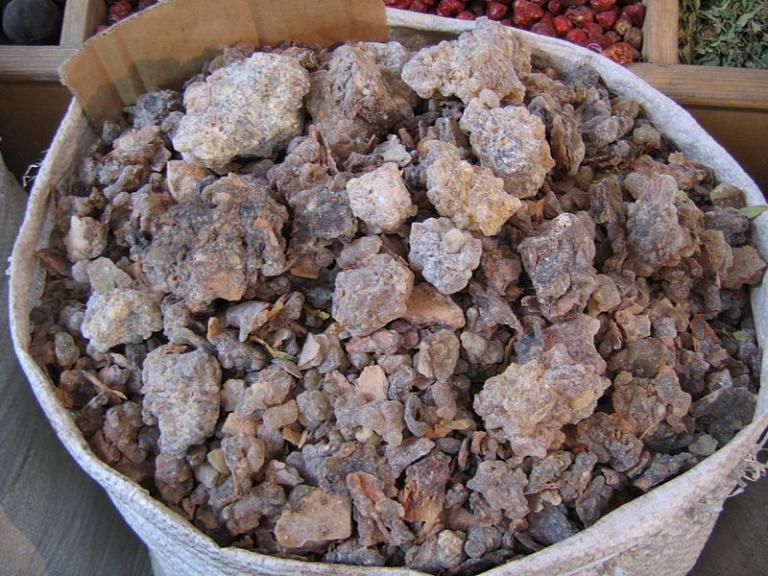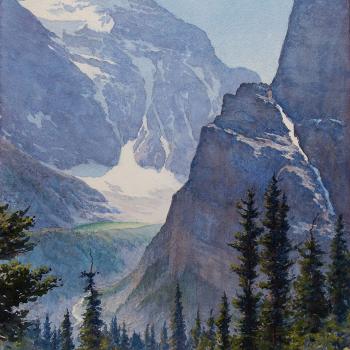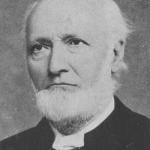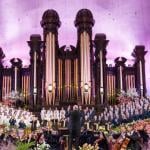
Continuing with my self-imposed writing assignment:
Frankincense is a fragrant gum resin consisting of small white chunks and beads that can easily be ground into a powder. When burned, this powder gives off a pleasant odor like that of balsam. The resin, milky white in color, was probably produced in the central district of Hadramawt, along the Indian Ocean coast of southern Arabia. From there, it was exported to Palestine and other parts of the Mediterranean world. The caravan routes for transporting Arabian incense and the products of Africa and India began in Sheba, the modern Yemen. The main route went north via the valleys and oases of the peninsula, through Mecca, and to Ma’an, where it split into two branches. One of these went west to Gaza and Egypt and the other north to Damascus.
The importance of this trade cannot be overestimated. The temples, and later the churches, of the eastern Mediterranean were hungry for frankincense, as were upper-class private dwellings. (The prophet Ezekiel, for instance, condemns a rich and unrighteous woman who sat “upon a stately bed, and a table prepared before it, whereupon thou hast set mine incense and mine oil.”)[1] Frankincense was used extensively in the rituals of the temple at Jerusalem.[2] It was a major and essential ingredient of the incense that was holy to the Lord, and the use of this incense for any unauthorized purpose was expressly forbidden in the law of Moses.[3] Such incense was burned on a specially dedicated and designed altar of incense by the high priest each morning and evening.[4] That altar stood just before the veil of the holy of holies in the temple, flanked on one side by the altar of “the bread of the presence” and on the other by the seven-branched candelabra.[5] Once a year the high priest was directed to carry a censer of burning incense as he entered the holy of holies and approached the mercy seat.[6] But the substance also played a role in the ordinary daily service of the temple. Of the Levites, the Old Testament says, “They shall teach Jacob thy judgments, and Israel thy law: they shall put incense before thee, and whole burnt sacrifice upon thine altar.”[7] Frankincense and oil were added to the cereal offerings.[8] Frankincense was placed with the “bread of the presence” before the holy of holies.[9] Such extensive use required large amounts of the precious material. In Herod’s day, we know that the temple consumed more than 600 pounds of incense each year, specially prepared according to a secret formula. Huge stores of the substance were kept in the temple treasury.[10]
The fragrance of the incense symbolized the prayers of God’s people, ascending upward to the divine throne. “Let my prayer be set forth before thee as incense,” says the Psalmist, “and the lifting up of my hands as the evening sacrifice.”[11] This notion continued into New Testament times. John the Revelator saw the four beasts and the twenty-four elders of his vision fall down before the Lamb of God, “having every one of them harps, and golden vials full of odours, which are the prayers of saints.”[12] When, however, the worship of the temple or the Church became merely an empty form, when the people lacked the proper spirit of sincere worship and devotion, the prophets were there to relate the Lord’s condemnation. Thus, in the days of Lehi, the prophet Jeremiah lashed out against such empty and meaningless worship: “To what purpose cometh there to me incense from Sheba? . . . Your burnt offerings are not acceptable, nor your sacrifices sweet unto me.”[13]
[1] Ezekiel 23:41.
[2] Also at the derivative Jewish temple at Elephantine in Egypt. On this, see “Advice of the Governors of Judah and Samaria to the Jews of Elephantine,” in James B. Pritchard, ed., Ancient Near Eastern Texts Relating to the Old Testament, 2d ed. (Princeton: Princeton University Press, 1955), 492. Many critics of the Book of Mormon, incidentally, have ridiculed the idea that a pious Jew, such as Nephi is alleged to have been, would ever have dreamed of building a temple outside of Jerusalem (2 Nephi 5:16). The Elephantine temple, however, near Aswan in upper Egypt, shows that the Book of Mormon is plausible on this point, and that its critics are incorrect. It was probably constructed at almost exactly the same time that Nephi built his temple in the Americas and functioned with the apparent approval of the authorities at Jerusalem. See Hayim Tadmor, in H. H. Ben-Sasson, A History of the Jewish People (Cambridge: Harvard University Press, 1976), 179-80; also Bezalel Porten, “Did the Ark Stop at Elephantine?” Biblical Archaeology Review 21/3 (May/June 1995): 54-67, 76-77. Later, yet another Jewish temple, that of Onias, was built at Leontopolis.
[3] Exodus 30:9, 34-38; Leviticus 10:1-3.
[4] Exodus 30:1-10. Luke 1:8-11 reflects this practice, although it suggests that, by the time of Christ, other priests were permitted to officiate in this service in place of the high priest.
[5] K. Galling, “Incense Altar,” in George Edward Buttrick, et al., eds., The Interpreter’s Dictionary of the Bible, 4 vols. and a supplement (Nashville: Abingdon, 1962-1976), 2:699-700, supplies references for the idea that at least one type of Israelite incense altar was itself borrowed from Arabia.
[6] Leviticus 16:12-13. The censers of ancient Israelite temple worship were of an interesting form, with the incense itself often resting in a “hand,” carved in cupping shape, at the end of a long handle which had been hollowed out to allow air to pass through in order to keep the incense burning. See L. E. Toombs, “Incense, Dish for,” in George Edward Buttrick, et al., eds., The Interpreter’s Dictionary of the Bible, 4 vols. and a supplement (Nashville: Abingdon, 1962-1976), 2:698-99, for a very brief article on the subject, with further references. The angel of Revelation 8:3-4 stands at the altar with a censer from which the prayers of the Saints ascend, mingled with incense. An intriguing image, I think, for Latter-day Saint temple-goers.
[7] Deuteronomy 33:10.
[8] Leviticus 2:1-2, 14-16; 6:14-18; compare Isaiah 43:23; Jeremiah 17:26; 41:5.
[9] Leviticus 24:7.
[10] 1 Chronicles 9:29; Nehemiah 13:5, 9.
[11] Psalm 141:2. Anciently, it was common to raise the hands heavenward as a gesture of prayer, as we today fold our hands or our arms. Some may find this significant. I do.
[12] Revelation 5:8; compare 8:3-4; also Luke 1:10. The marginal note in the KJV to the word “odours” suggests “incense” as an alternate reading, which is precisely correct.
[13] Jeremiah 6:20.
Posted from Stockholm, Sweden











